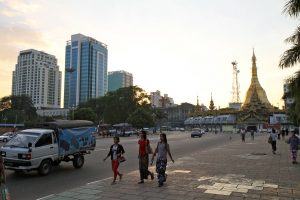The coronavirus continues its rapid spread in Myanmar, with the number of confirmed cases surpassing 90,000 and threatening to spread to neighboring countries. After months of being relatively untouched by the virus, the country is now the third-most affected nation in Southeast Asia, after Indonesia and the Philippines. As of December 1, it had notched 92,189 confirmed cases of COVID-19, and 1,941 fatalities, with more than a thousand new infections each day.
While these numbers remain low compared to those currently being clocked up by the likes of the United States, India, and Brazil, the spread of the disease reportedly threatens to overwhelm Myanmar’s ramshackle health system.
“Amid the prolonged pandemic, medical staff are becoming overburdened,” Maw Maw Oo, a senior emergency physician at the Yangon General Hospital, told Radio Free Asia. “In some cases, they are forced to take long shifts with no time off, working day and night. Many feel disheartened. If the government doesn’t contain the virus effectively, hospital and clinics will not be able to handle the load. It will become a disaster if medical staff become exhausted and can no longer work.”
Myanmar’s COVID-19 situation was clearly not helped by the government’s decision to forge ahead with national elections on November 8, after infections spiked on the eve of the two-month campaign period. While the election authorities instituted strict social distancing regulations at polling stations and banned large-scale gatherings during the campaign period (something that may have contributed to the thundering victory of the ruling National League for Democracy), the election has inevitably complicated efforts to curb the spread of the disease.
After the election, the government issued an order banning gatherings of more than 30 people, but members of the public are not adhering to the decree strictly enough to “flatten the curve” of Myanmar’s long first wave. According to The Irrawaddy, hundreds of people ignored ventured out of their homes in Yangon for the Tazaungdaing holiday from November 27-30, despite the imposition of stay-at-home orders in Myanmar’s largest city.
On November 30, the government’s Central Committee for Prevention, Control and Treatment of COVID-19 extended a suspension on domestic flights until December 15. It has also extended until December 31 a ban on international flights that has been in place since March.
If the outbreak continues to spread, it could be bad news for neighboring countries. Myanmar has long, porous, and loosely policed borders with Thailand and China, long stretches of which abutting regions under the de facto control of the rebel groups and ethnic insurgent organizations. It is also home to large populations of undocumented migrant workers, many of whom have little choice but to continue venturing across borders in search of work. Both of these things make Myanmar a potential vector for crossborder transmission.
In September, the Chinese city of Ruili on the border with Myanmar in Yunnan province went into “wartime mode” after two people entered the city illegally from Myanmar, leading the authorities to test all 200,000 of the city’s residents. A similar thing happened in northern Thailand last week, when at least four Thai nationals crossed the border illegally and later tested positive for the disease, prompting quick action by the authorities to contain a potential outbreak.
It is worth noting again that the numbers in Myanmar remain low in comparison with the worst-affected countries. But the country’s stubborn first wave of infections testifies to the immense challenges of conquering and containing COVID-19, especially in a region of Southeast Asia where borders are hazy and loosely policed.

































